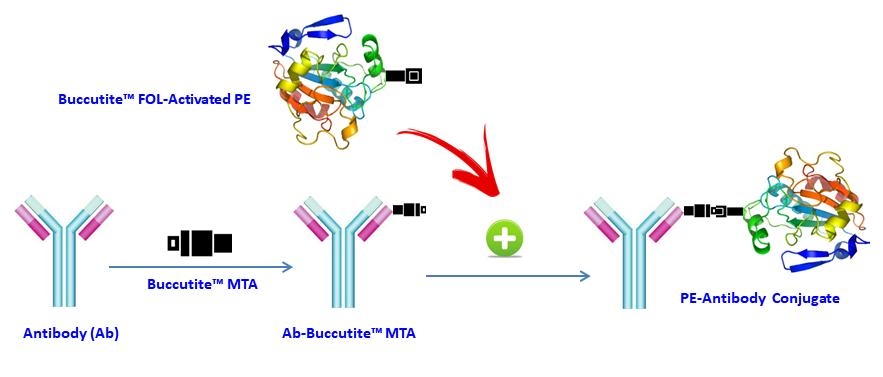Buccutite™ Rapid PE-Cy5.5 Tandem Antibody Labeling Kit
Microscale Optimized for Labeling 25 ug Antibody Per Reaction
PE-Cy5.5 is a popular color used in flow cytometry. Its primary absorption peak is at 565 nm with emission peak at~700 nm. The filter sets of 682/33 nm and 695/40 nm are recommended for this tandem color. AAT Bioquest offers this Buccutite™ rapid labeling kit to facilitate the PE-Cy5.5 tandem conjugations to antibodies and other proteins such as streptavidin and other secondary reagents. Buccutite™ PE-Cy5.5 Conjugation Kit provides a robust and convenient method to conjugate your antibodies with PE. The kit includes a preactivated PE and reaction buffer. The entire process only requires two simple mixings without further purification required. The conjugated antibody can be used in flow cytometry, WB, ELISA and IHC applications. This kit is sufficient for 2 labeling reactions, each up to 25 ug of antibody. Considering the large size of PE (240 kDa), the amount of antibody used in a labeling reaction must always be less than the amount of PE. The best ratio for any new antibody reagent must be determined by experimentation but 25 ug of IgG antibody for every 50 ug of PE usually gives optimal results. Our kit provides preactivated PE-Cy5.5 to facilitate the PE-Cy5.5 tandem conjugations to antibodies and other proteins such as streptavidin and other secondary reagents. Our preactivated PE-Cy5.5 tandem is ready to conjugate, giving much higher yield than the conventionally tedious SMCC-based conjugation chemistry. In addition, our preactivated PE-Cy5.5 tandem is conjugated to a protein via its amino group that is abundant in proteins while SMCC chemistry targets the thiol group that has to be regenerated by the reduction of antibodies.


| Catalog | Size | Price | Quantity |
|---|---|---|---|
| 1341 | 2 Labelings | Price |
Spectral properties
| Extinction coefficient (cm -1 M -1) | 1960000 |
| Excitation (nm) | 565 |
| Emission (nm) | 671 |
Storage, safety and handling
| H-phrase | H303, H313, H333 |
| Hazard symbol | XN |
| Intended use | Research Use Only (RUO) |
| R-phrase | R20, R21, R22 |
| UNSPSC | 12171501 |
Documents
Contact us
| Telephone | |
| Fax | |
| sales@aatbio.com | |
| International | See distributors |
| Bulk request | Inquire |
| Custom size | Inquire |
| Technical Support | Contact us |
| Request quotation | Request |
| Purchase order | Send to sales@aatbio.com |
| Shipping | Standard overnight for United States, inquire for international |
Page updated on December 17, 2025

